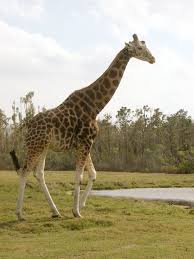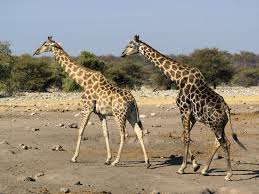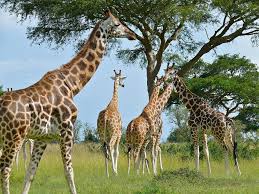The northern giraffe is a species of giraffe, and is considered the type species of the genus. Whilst three
other giraffe species were once considered subspecies of the conglomerate Giraffa camelopardalis species,
recent studies have identified the northern giraffe as one of the four separate species of a reorganised
Giraffa genus. This species is composed of three subspecies: the Nubian giraffe (G. c. camelopardalis),
Kordofan giraffe (G.c antiquorom) and West African giraffe (G.c. peralta). Around 4,550 individuals from all
subspecies are currently present in the wild.
Description
The Giraffe has an enormously long neck which allows it to exploit the leaves and vegetation that are too
high up for other animals to find. Despite their length, the neck of the Giraffe actually contains the same
number of bones as numerous other hoofed mammals but they are simply longer in shape. The Giraffe's elongated
neck leads into a short body, with long and thin, straight legs and a long tail that is tipped with a black
tuft that helps to keep flies away. The Giraffe tends to be white in colour with brown or reddish markings
that cover it's body (with the exception of their white lower legs). The markings of each Giraffe are not
only unique to that individual but they also vary greatly between the different Giraffe species in size,
colour and the amount of white that surrounds them. All Giraffes though have large eyes that along with
their height give them excellent vision, and small horn-like ossicones on the top of their heads.
Distributión and habitat
Previously found even in North Africa, today the remaining Giraffe populations are restricted to parts of
sub-Saharan Africa with the largest concentrations being found in National Parks. Giraffes inhabit open
woodlands and savannah where using their height they are able to see for great distances around them to
watch out for approaching danger. The nine different Giraffe species are found in varying countries on the
continent, each exploiting their local ecological niche.
Due to the fact that Giraffes feed on vegetation
that is high in the trees but also too woody for the mouths of smaller herbivores, they are also able to
remain in areas where domestic grazing has obliterated the plant species close to the ground, forcing the
species that feed on them to move on. Giraffes throughout Africa though have been drastically affected by
the loss of vast regions of their natural habitats.
Diet and prey
The Giraffe is a herbivorous animal that has evolved to be the height that it is so that it has less
competition for food on the higher branches of the canopy. Giraffes are known to eat up to 60 different
species of plant throughout the year and do so by grabbing onto branches with their long, black tongue
(that can grow up to 18 inches long) and using their tough prehensile lips and flattened, grooved teeth are
able to strip the leaves off the branches. Giraffes most commonly eat from acacia trees but also browse for
wild apricots, flowers, fruits and buds along with eating seeds and fresh grass just after the rains.
Giraffes get 70% of their moisture from their food so need to drink very little but when they do come across
clean water, they must splay their front legs (which are longer than the back) in order to get their head
close enough to the ground to drink.
Behavior and life style
The large size of the Giraffe means that it must spend a great deal of time eating which it tends to do the
most during the more tolerable heat of the morning and evening. During the hot midday sun, Giraffes rest in
more shaded regions where they (like a number of their relatives) regurgitate their food known as cud,
before then consuming it again. Small herds comprised of a number of females and their young spend both the
day and night together to protect their offspring from predators, but male Giraffes are much more solitary
often roaming over large areas in search of a fertile female. If however they come into contact with a rival
male, the two will begin to bump heads and interlock their necks as a way of establishing a dominance
hierarchy, with the winner earning the right to mate with the local females.
Reproduction and life cycles
Giraffes breed year round and after finding a female to mate with, the male Giraffe will resume his solitary
ways. After a gestation period that lasts for 15 months, the female Giraffe gives birth to a single infant
(twins are rare) that already stands at two meters tall and has it's unique markings. Giraffe calves look the
same as adult Giraffes but simply become even bigger and more elongated as the grow and mature. After birth,
the female Giraffe will often keep her calf away from the rest of the herd for an average of 15 days and the
calf will then be weaned when it is just over a year old. Male Giraffes are able to breed a year later than
females, but are sometimes not successful until they are nearly eight years old. Although both male and
female young Giraffes will join small groups males tend to become more solitary with age, where females
remain together but will often wander between different herds.
Predators and threats
Despite being the tallest land animal in the world, the Giraffe is actually preyed upon by a number of large
carnivores that co-inhabit the dry savannah. Lions are the primarily predators of the Giraffe that use the
strength of the whole pride to catch their victim, but they are also preyed upon by Leopards and Hyenas.
Giraffes rely on the vast open plains so that they can have the best view possible of their surroundings but
if a predators does get too close, Giraffes kick their attacker with their large, heavy feet to defend
themselves. Young calves however, are much more vulnerable and rely on the protection of their mother and
the herd. Sadly though, around 50% of young Giraffes do not make it past the age of 6 months due to
predation. All Giraffes are also threatened by hunting from Humans with populations having completely
disappeared from certain areas.










